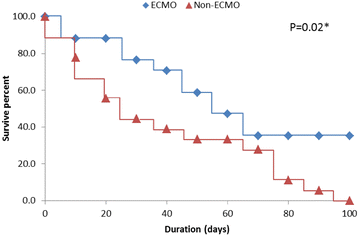Extracorporeal membrane oxygenation for severe Middle East respiratory syndrome coronavirus
- PMID: 29330690
- PMCID: PMC5768582
- DOI: 10.1186/s13613-017-0350-x
Extracorporeal membrane oxygenation for severe Middle East respiratory syndrome coronavirus
Abstract
Background: Middle East respiratory syndrome (MERS) is caused by a coronavirus (MERS-CoV) and is characterized by hypoxemic respiratory failure. The objective of this study is to compare the outcomes of MERS-CoV patients before and after the availability of extracorporeal membrane oxygenation (ECMO) as a rescue therapy in severely hypoxemic patients who failed conventional strategies.
Methods: We collected data retrospectively on MERS-CoV patients with refractory respiratory failure from April 2014 to December 2015 in 5 intensive care units (ICUs) in Saudi Arabia. Patients were classified into two groups: ECMO versus conventional therapy. Our primary outcome was in-hospital mortality; secondary outcomes included ICU and hospital length of stay.
Results: Thirty-five patients were included; 17 received ECMO and 18 received conventional therapy. Both groups had similar baseline characteristics. The ECMO group had lower in-hospital mortality (65 vs. 100%, P = 0.02), longer ICU stay (median 25 vs. 8 days, respectively, P < 0.01), and similar hospital stay (median 41 vs. 31 days, P = 0.421). In addition, patients in the ECMO group had better PaO2/FiO2 at days 7 and 14 of admission to the ICU (124 vs. 63, and 138 vs. 36, P < 0.05), and less use of norepinephrine at days 1 and 14 (29 vs. 80%; and 36 vs. 93%, P < 0.05).
Conclusions: ECMO use, as a rescue therapy, was associated with lower mortality in MERS patients with refractory hypoxemia. The results of this, largest to date, support the use of ECMO as a rescue therapy in patients with severe MERS-CoV.
Keywords: Coronavirus infection; Extracorporeal membrane oxygenation; Rescue therapy; Signs and symptoms respiratory.
Figures
Comment in
-
Poor survival with extracorporeal membrane oxygenation in acute respiratory distress syndrome (ARDS) due to coronavirus disease 2019 (COVID-19): Pooled analysis of early reports.J Crit Care. 2020 Aug;58:27-28. doi: 10.1016/j.jcrc.2020.03.011. Epub 2020 Apr 1. J Crit Care. 2020. PMID: 32279018 Free PMC article. No abstract available.
References
-
- http://www.who.int/emergencies/mers-cov/mers-summary-2016.pdf. Assessed 12 March 2017.
-
- http://www.moh.gov.sa/en/CCC/PressReleases/Pages/default.aspx. Assessed 12 March 2017.
-
- Brower R, Matthay M, Morris A, Schoenfeld D, Thompson BT, Wheeler A. Ventilation with lower tidal volumes as compared with traditional tidal volumes for acute lung injury and the acute respiratory distress syndrome. The acute respiratory distress syndrome network. N Engl J Med. 2000;342(18):1301–8. doi: 10.1056/NEJM200005043421801. - DOI - PubMed
LinkOut - more resources
Full Text Sources
Other Literature Sources
Miscellaneous


